|
 Diane
Osborn introduced Glick, a Logan County Native. Glick retired from
the Navy after 20 years and worked for six years at Choate
Correctional Center in Anna, Illinois. Diane
Osborn introduced Glick, a Logan County Native. Glick retired from
the Navy after 20 years and worked for six years at Choate
Correctional Center in Anna, Illinois.
In her introduction, Osborn said Glick has always had a strong
interest in the State School/Lincoln Developmental Center. Osborn
said the Lincoln Developmental Center was originally called the
Asylum for Feeble Minded Children, which she found interesting.
Because Glick worked in a mental hospital and with the
developmentally disabled, he had some familiarity with the topic.
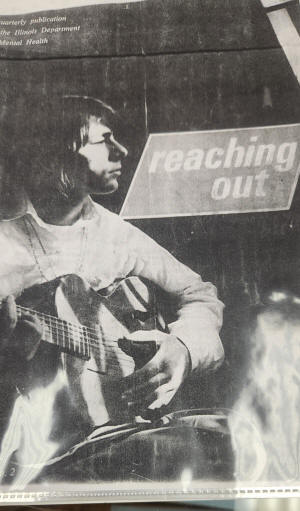
While researching LDC, Glick found a 2011 journal put
out by the State of Illinois with a chapter about the Lincoln
Developmental Center. He also spent a few hours at the public
library looking at a book on LDC’s history from beginning to its
2002 demise.
LDC had a long history as far as the different names and who
administrative responsibilities fell under. Glick said it was called
the Illinois Asylum for Feeble Minded Children from its founding in
1877 until 1909. It was then called the Lincoln State School and
Colony from 1909 to 1953. It was called Lincoln State School from
1953 to 1975. He said the final name was the Lincoln Developmental
Center from 1975 until it closed in 2002.
As for administrative responsibilities, Glick said the Board of
State Commissions and Public Charities oversaw it from 1871 to 1909.
He said that was prior to the school coming into Lincoln in 1877.
From 1909 to 1917, the Board of Administrations oversaw the school.
From 1917 to 1961, it was administrated by the Department of Public
Welfare. From 1961 to 1965, the Department of Mental Health oversaw
it.

Finally, from 1965 to 2002, Glick said the school was
administrated by the Department of Developmental Disabilities and
Mental Health.
Originally, Glick said when the school opened there was one building
strictly utilized for Civil War veterans with “coping and
compensating issues” or what we know today as Post Traumatic Stress
Disorder. He said people were not sure how to help them with those
issues back then.
June 5,1855 an act of legislation was created by the State Medical
Society. Glick said the State Medical Society’s actions established
the institution. Dr. David Pritz, Dr. E.R. Roe and Dr. J.V.C. Planey
were part of the group who started it.
Early on, Glick said the school was established as an institution
for idiots. He said in September 1865, Dr. Wilbur was elected as the
first superintendent of the institution.
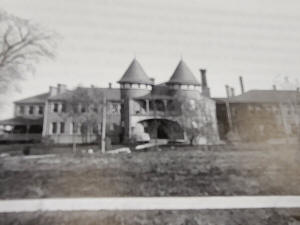
Construction began in 1875. Glick said it was
finished in 1877 at a cost of $170,000. He said it would likely cost
several million dollars to build it today.
The first building was 324 feet wide, 215 feet in depth. Glick said
the highest point at the center of the building was 100 feet high.
The outskirts were 75 feet high.
Glick said the building accommodated 300 pupils. It originally began
as an experimental center for children. Only later would it also be
for adults.
By 1884, Glick said they added a laundry building, which his great
grandmother worked in. A cottage hospital was finished in 1886.
Glick said that means they went nine years without having a hospital
set up for the residents.
Before the building was acquired, Glick said there was a lot of
legislation surrounding the establishment of the experimental
school. The school was intended for the instruction and training of
“idiots and feeble minded.”
Originally, Glick said there was an Experimental School for Idiots
and Feeble Minded Children [established by the State of Illinois] in
Jacksonville in 1865. By 1875, the school in Jacksonville was
overcrowded. Some of its residents moved to Lincoln in 1877 to
offset the overcrowding at the Jacksonville School.
The school in Lincoln was established as an experimental center for
the instruction and training of idiots and feeble minded. As Glick
said, those titles would probably cause a lawsuit today. Glick said
they worked with the children to develop their minds and help them
function better.

The capacity of the main building was 300. Glick said
the institution was geared for children between seven and fourteen
who were classified as idiotic and deficient in intelligence.
The goals of the institution were to improve children’s health and
teach them about bathing and the use of appropriate medication.
Glick said many children were not sure why they took the
medications.
One mile south of the facility 400 acres were leased in September
1877. Glick said a colony of boys lived at the farm and were
overseen by a husband and wife who owned the farm. Two hundred acres
was used for farming and crops. The other 200 acres were used for
pasture and raising livestock.
In 1887, Glick said all the beef for the facility came from the
farm. He said the place was almost completely self-sufficient
raising its own food and produce and having it prepared right there.
Eventually, Glick said the farm was expanded to nearly 500 acres.
Fifty acres were adjoining the farm, and 40 of those acres were in
Broadwell Township.
A farmer was hired to oversee the colony of 30 boys working at the
farm. At some point, Glick said growing wheat and corn ended when it
became unprofitable. It was then considered more practical to use
everything from the farm at the school. He said the school was like
a city of its own within the city since everything was provided by
the farm.
The state later purchased 725 acres of land and built two wards.
That way, Glick said individuals did not have to travel from the
farm back to the school and 625 men were housed there.
In 1917, Glick said numerous improvements were underway including
tunnels from the powerhouse, which still stands today. The tunnels
were dug as part of the steam power. He said residents helped run
new steam lines for heat into the buildings and power lines to build
up new bases for power in the buildings.
From the powerhouse, Glick said these tunnels branched off and led
to all the buildings at the facility.
One tunnel ran from the old hospital, infirmary and morgue and lead
out to the school’s cemetery by the prison. Glick said that way,
people from the facility could be brought out to be laid to rest
without everyone seeing them carry out the body.
Today, small sections of this tunnel can still be seen with a couple
of embankments when you are going from old 66 towards Highway 55,
but Glick said the area is blocked off. When people want to visit
the cemetery, he said they must get permission from people at the
prison and show their IDs. Guards function as escorts to and from
the cemetery.
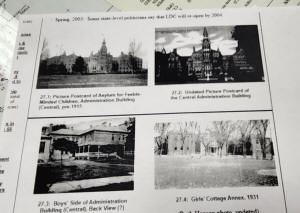
When Franklin Delano Roosevelt’s New Deal program was
established in the 1930s, Glick said the school then received
$30,000,000 for improvements.
The funding supplied the institution with boilers for heat. Glick
said some of the funds were used to help with power, sewage disposal
and heavy equipment for the reconstruction and refurbishment of the
old buildings. It helped relieve the overcrowding. The new housing
space brought their capacity from 1,000 to much more as the space
had 4,800 beds.
From 1945 to 1955, the Illinois Department of Welfare received $10M
for renovations at the facility. Glick said many medical
improvements were made during the following years. For example, a
pharmacy and dental facility were built, the surgical wards were
improved, and an X-Ray machine was brought in.
There were more doctors, dentists and other health care
professionals hired. Glick said some of these professionals included
counselors, social workers, psychologists and psychiatrists.
When veterans would come in and when psychologists worked with them,
Glick said they often did not know how to properly deal with their
issues. Most of these professionals had just worked with civilians
and not veterans. Unfortunately, Glick learned that when working at
Choate.
Veterans like Glick and two others would sometimes confront
psychologists, but he said they were told they were uneducated.
Once the psychologists and psychiatrists finally
listened, Glick said people were able to get out of the facility
within weeks. One of Glick’s pet peeves when working in a mental
health facility was the mental health professionals not knowing how
to work with the veteran’s mental health issues.
[to top of second column] |

Changes in mental health treatment over time
Next, Glick talked more about the changes he has seen over the years
in the approach to treating mental health. When Glick worked at
Choate years ago, he said treatment was very different. Treatments
then would include Electric Shock Therapy with paddles to the side
of the head leading to the brain. Some people had lobotomies.
Both children and adults were put in what was called a crib if they
fought the staff. Glick said small wooden cribs were set up for
children and larger ones were set up for adults. Once they were in
the crib, he said the top would be locked until they could stop
fighting staff.
The tunnels below the hospital had numbers on them. Glick said at
one time these areas had rings and shackles hanging from the walls
as one way to deal with out of control residents.
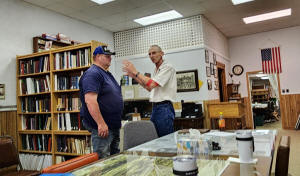
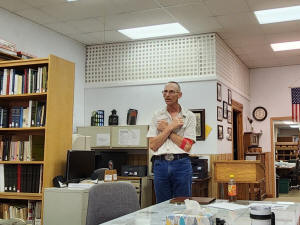
New guidelines have changed the way patients are
treated. Glick said now professionals try to create a distance and
talk to people who are upset to calm them down and relax them.
One patient Glick worked with would hit the block wall and go to the
other side of a room and do the same thing. She would not listen to
reason, so Glick said they put her in a physical hold.
To put patients in a physical hold, you come in from behind, cross
your arms and lay your head against theirs to keep them from banging
their head. The hold is only for one and half minutes before you
release pressure.
If patients have not calmed down after you do that, Glick said to
repeat the action until they have calmed them.
One man Glick recalls had been taken off all of his medications by
psychiatrists and psychologist while at a different facility. The
man became violent at the other place and was sent back to Choate.
When Glick was leaving work late one night, a technician called him
for help. Glick had to help the tech by talking to the man and
coaxing him back to the men’s hallway. The man responded by cussing
at Glick and slugging him. He knocked out one of Glick’s teeth and
bruised Glick’s ribs when Glick hit the concrete.
A code orange alert would bring everyone running to assist. If a
physical hold did not help, Glick said they used a humane wrap where
a wrap is tied around patients. The patients would then be carried
by six people to a cushioned and padded restraint room and have
their ankles and wrists bound but padded. You have to make sure
there is enough space that their circulation is not cut off.

If patients still do not calm down, Glick said they
then use the fifth point, a padded section that comes over the top
to keep them from beating their heads against the wall.
The last resort is what Glick said they called a 10-2-100 using a
combination of Adavan, Haldol and Benadryl. It was used to get
patients to calm down and go to sleep so they could go back to their
room. Glick said it was intended to keep them from becoming even
more violent and hurting themselves or others or even damaging
property.
In the present day, Glick said they try to treat people by talking
to them first to calm them down. The chemical restraints are a last
resort.
Other interesting facts
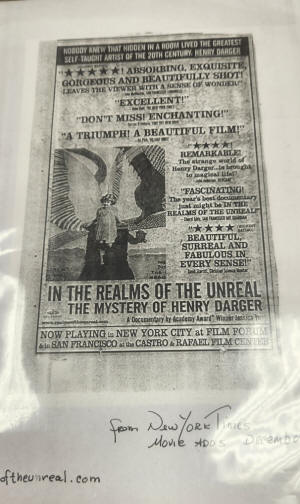
There were two very prominent individuals at LDC.
Glick said one was a patient named Henry Darger who made outside art
to exhibit.
One patient, who they named John Doe 24, was found
early one morning October 11, 1945, in Jacksonville. Glick said the
man was unable to communicate with anyone due to being deaf and
mute. The man was labelled feeble minded and sentenced by a judge to
the Lincoln State School. Glick said he remained in the Illinois
Mental Health system for over 30 years. John Doe 24 died in the
Sheridan Oaks Nursing Home in Peoria in 1993.
Singer/songwriter Mary Chapin Carpenter wrote a song about John Doe
24 titled “God Knows His Name.” Glick said when Carpenter found out
about the man and how he was laid to rest, she bought a headstone
for the man and had it placed in Peoria.
For many people whose name staff did not know, Glick said they were
referred to as John Doe with a number behind their names, which he
finds undignified.
Glick asked if there were any questions.
One person asked what president closed Lincoln Developmental Center.
When LDC closed, Glick said it was Illinois Governor George Ryan who
chose to close it. The President then was George W. Bush.
Gary Dodson said when Ronald Reagan was the president, he had
started paperwork and a push to close facilities.
With the tunnels Glick mentioned, Dodson said tunnels were put into
effect in all prisons in the state of Illinois so people could get
from one building to another.
In the prison system, Dodson said some past mental health treatments
are still utilized. He is a retired state policeman and said the
Department of Corrections still has their foot in some facilities.
There was a question from Dodson about how many residents had come
to Lincoln from Jacksonville.
In researching, Glick said he had not been able to find that
information. The facility in Jacksonville is now closed too.
Though the children at the state school had farming abilities,
Dodson felt they did not get enough credit for these abilities.
To give the children self-sufficiency, Glick said many at the school
learned to make clothes, linens and shoes. Some people thought it
was inhumane to make them do that, but Glick and others said it gave
them a sense of self-worth.

Some people were sent there just because their family
could not care for them. One man said when evaluated, they did not
have developmental disabilities.
David Glick, whose mother-in-law worked at LDC, said some parents
treated the school as an orphanage. Many of the people there really
did not need to be there.
Dodson, who taught at LDC while he was a state policeman, remembers
trying to teach residents how to get along with people. He would
play games with some of the residents. Dodson said some of them were
“slow” but were not “idiots.” He feels an injustice was done when
the place was closed.
Someone said his wife found some of the residents acted better when
they moved to a good group home.
Usually, Chris Glick said a group home is a better environment.
However, some are not able to manage living in a group home. They
have to be able to work or go to workshop.
In 1969 and 1970, Cheryl Hall’s husband Gary was an administrator at
the state school. She said some residents were juvenile delinquents
from Chicago sent there because they could not pass tests due to
lack of education.
There was a question of when some of the buildings were erected.
In 1877, some buildings were erected. Later, Chris Glick said there
were ten buildings built for the colony and they housed up to 620
men. Funding from the state helped with the building. He is not sure
how many buildings are there.
Something David Glick recalled was that his stepmother had a family
member at LDC, who died at age 26. When the mother tried to visit
the cemetery, she found there were too many regulations. He said the
mother eventually stopped visiting the cemetery.
When Ruby Bartman-Nimke was a student nurse in the late 1950s, she
said she went out to the state school and saw a baby with
hydrocephalus. Hydrocephalus, which is water on the brain, caused
the baby to have a very large head nearly as big as a card table.
Bartman-Nimke said the baby could not be moved. Fortunately, now
there is neurosurgery to drain the fluid.
For those interested in more of the history of LDC, Diane Osborne
said the genealogical society has a large collection from there
which includes tables, a podium, dishes, records, and scrapbooks.
She said the Logan County Tourism office has postcards, a copper
box, and part of the silver service from LDC.
Next month, Bill Gossett will speak about the past 100 years of
Lincoln history. The meeting will be held at the Logan County
Genealogical and Historical Society Monday, June 17 at 6:30 p.m.
[Angela Reiners]

|